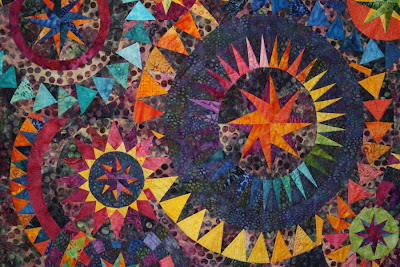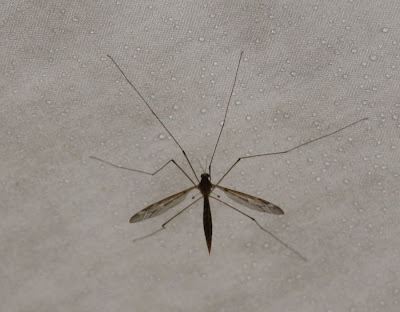For those who are not familiar with this term, it basically means making one print of something (marbling is a subset of monoprinting). There are many ways of achieving monoprints, but the type I have done was to paint either paints or dyes onto some surface, spread a piece of fabric on top and then use a brayer rolled on top of the fabric to make sure that all the color adheres to the cloth. There are all sorts of surfaces on which you can paint and all sorts of interesting things you can put on the surface. Your imagination is your limit. You can really mix the colors or keep them separate -- you can leave lots of white space or none! Sometimes, you can even get a "ghost" print which is a pale copy of the first print and sometimes a good start on another piece of cloth. It is fingerpainting if you want it to be!
It has been awhile since I have done any monoprinting but it is an activity that I truly love (as evidenced by my 125 yards of marbled fabric). So back to the dyes. As I am trying to use up some of my aging dyes, I had to limit my pallette a bit (always a struggle for me) as bright blue, fuchsia and navy are pretty much among the missing. Grape, turquoise, mixing red, sun yellow, golden yellow, strong orange, burnt orange and mixing blue were still to be used though.
I decided the baby tshirt should be grape and turquoise so we shall see how that comes out. (I am not liking the quality of the fabric for dyeing as much as my cheapie K Mart tshirts though - it doesn't seem to take the color as well but we shall see).
My setup for monoprinting differed a bit this time and so did my process -- all because of my inherent impatience! I had a bunch of twill that I had bought at Joanns (60 in wide) that I had dyed before and it had dyed beautifully. It makes great aprons and tote bags!
When I took Ann Johnston's monoprinting class a few years back, one of the students in the class was using the skinny foam that you can buy in 30 x 60 inch rolled up sheets at Joanns -- the stuff from which they make those foam shapes for kids. They are about 1/4 inch thick and seemed to hold the dye very well. (It is great stuff from which to make "rubber" stamps as well.) In the past I have used either plastic sheets, glass, thin acrylic sheets or white bathroom board as a surface from which to monoprint.
I made up about 1/2 cup of thickened dyes of each color by taking really thick print paste and mixing it 1:1 with 10% liquid MX dyes. I rolled out this sheet of foam and poured dyes all over the whole sheet. I then used scrapers and tile grout grooved scrapers to move the dye around. Then I laid a rather large piece of this twill (which had been pre- treated with a soda ash solution and dried) over it and used a brayer to roll over the back of the whole piece. The first piece was primarily blues and purples but I couldn't resist throwing some yellows on at the end. The second piece was warm colors. I then picked up each of the monoprinted pieces, and found a nice piece of plastic for it to lay on and covered it with another piece of plastic.
I then just fooled around with small pieces painting the dye on the foam and lifting it with small pieces of fabric and then doing some painting directly on top -- I hate white!
Later I uncovered my pieces (maybe an hour later) and painted some more color onto the places that hadn't picked up as much dye during the monoprinting process. After about three hours I decided it was time to finish these suckers off as I was dying to see what they looked like!! They had been in my basement which is notoriously cool even in the summer and not a great place for batching and they were really too unwieldy to bring upstairs and outside. So I rolled up the pieces one at a time in their plastic so there wouldn't be any movement of color and nuked them for about 4 minutes until they were steamy hot (each piece was about 30 inches by 60 inches).
My washing process is to rinse the soda ash out in two bucketsful of water, first cold and then warm. I then wash for 1/2 hour in the hottest cycle of the washer with the highest level of water with some synthrapol and do a double rinse after that. If I were selling it, I would do this process twice.
Lessons Learned this Time:
1. Remember which is the alum bucket and which is the soda ash bucket. Alum does nothing for MX dyes!! (I know)
2. Don't work on pieces of fabric that are 60 inches by 36 when experimenting!
3. When painting over a water soluble resist like rice paste, always use thickened dyes rather than the liquid dyes unless you like fuzzy.
4. If you pretend your microwave is a steamer and use plastic instead of paper to separate the layers, everything works just fine!
5. Sprinkling salt on a layer of dyes on a piece of foam doesn't drag the color like it does on fabric but it does concentrate the color in small dots.
6. Dyeing over the soy paint is like adding a layer of dye -- the soy paint layer does not act like a paint and resist the color as acrylics do.
7. Mixing Blue and Turquoise mixed together make an awesome blue!
I can't wait to get back down to the dye table tomorrow!! Pictures tomorrow as well!
 This was my favorite in the whole show. It was done by Penelope Shumacher after seeing the pattern that she loved. It took her 7 mos and then she hand quilted it. Her fabric choices are wonderful!
This was my favorite in the whole show. It was done by Penelope Shumacher after seeing the pattern that she loved. It took her 7 mos and then she hand quilted it. Her fabric choices are wonderful! I liked this scrappy quilt which uses some of those Japanese prints that we all collect.
I liked this scrappy quilt which uses some of those Japanese prints that we all collect. I loved this house quilt by Pat Daniels. There are all sorts of surprises when you look closely at it!
I loved this house quilt by Pat Daniels. There are all sorts of surprises when you look closely at it! This was a beautifully done William Morris applique quilt.
This was a beautifully done William Morris applique quilt. I absolutely loved this quite large quilt which was basically made up of miniature blocks. It had over 9900 pieces and I loved its scrappy nature. This was my favorite of the larger quilts! It was by Susan Pierson and Debbie Kinney.
I absolutely loved this quite large quilt which was basically made up of miniature blocks. It had over 9900 pieces and I loved its scrappy nature. This was my favorite of the larger quilts! It was by Susan Pierson and Debbie Kinney.









































